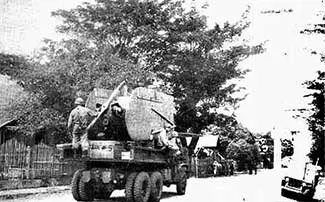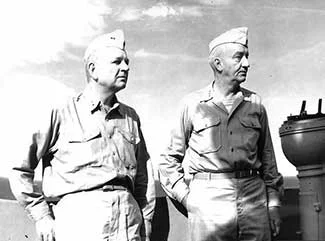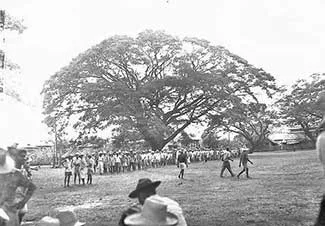Details of the Historic Nasugbu Landing from the Viewpoint of the 11th Airborne Division
[In this page: Nasugbu, Nasugbu Landing, 11th Airborne Division, US Sixth Army, US Eighth Army, Lingayen Gulf Invasion]
Read: “The Nasugbu Landing in WWII and Its Significance to the Liberation of Batangas.”
The 11th Airborne was first activated on 25 February 1943 but was initially held in reserve in the United States in the first half of 1944. By June, the division was sent to the Pacific Theatre of Operations and first saw action during the invasion of Leyte in October.
With Leyte firmly in their hands, by January the Americans had the invasion of Luzon in their sights. On 9 January, assisted by the United States Navy and the Royal Australian Navy, the forces of the United States 6th Army had landed on the beachheads of Lingayen and San Fabian4. From there it would tear down south to liberate the capital city of Manila.
 |
| A light plane being carried on a truck through a street in Nasugbu, 1945. Image source: Eyes Of The War: A Photographic Report Of World War II, Vol. II. |
“11th A/B will land one regimental combat team (RCT) on X-day and H-hour in the Nasugbu area, seize and defend a beachhead; 511th Parachute Regimental Combat Team will be prepared to move by air from Leyte and Mindoro bases, land by parachute on Tagaytay Ridge, effect a junction with the force of the 11th A/B Div moving inland from Nasugbu; the 11th A/B Div, reinforced, after assembling on Tagaytay Ridge will be prepared for further action to the north and east as directed by the Commanding General, Eighth Army.
“Sixth Army was advancing rapidly toward Manila from the north and shoving the Japs south. We were the force that was to block the Jap escape routes to the south. We were to find out what the Japs had in Southern Luzon, and if General Eichelberger5 thought it practicable to advance on Manila, we would do so.”
Before setting out for Mindoro, where it would be based for a few days before hopping over to Nasugbu, the 11th participated in a dry run of the landing in Leyte on 26 January. After the successful practice, the troops boarded their ships and sailed from Leyte to Luzon.
The convoy was led by the command ship Spencer and was made up of four “four APDs (high speed transport ships), destroyers from which personnel were landed in LCPs (a type of landing craft), thirty-two LCIs (a craft for landing infantry directly onto the beach) and six LSTs (a type of landing craft that could carry tanks, vehicles, troops and cargo onto the beach).” The convoy was to take the troops to Mindoro where it would await orders.
The last day of January was designated X-day (for “attack day”) or the implementation of Operation Mike VI, the code name for the Nasugbu Landing. Flanagan wrote:
“The convoy arrived at dawn offshore at Nasugbu Bay. We could see the white beaches and the town of Nasugbu; we could see the green mountains of Southern Luzon; we could wonder what the Nips (slang for Japanese) had there waiting for us. At 0715, the Navy began shelling our landing area, Red Beach, from destroyers and rocket-firing LCIs.”
Read: “Particulars of the Now-Defunct Nasugbu ‘Landing' or Airfield, Pre-WWII and onwards”
“Nasugbu was relatively untouched by the war and was the first town of any consequence that we had seen since we left the States. It was complete with (a) village square and bandstand, the site of the first Division CP (command post) in Luzon.
“After we had arrived in the town, European men and women, refugees from the bombing of Manila, were on hand with the Filipinos to give us a tumultuous welcome. Precious food stocks, bananas, eggs, chickens and papayas carefully hoarded for this occasion were brought out for us. Everywhere ‘Veectoree!’ and ‘God bless you!’ were on the tongues of the shouting, laughing, crying people. ‘Mabuhay!’ they said and ‘Mabuhay!’ we answered – ‘Hooray!’ ”
 |
| Spanish evacuees from Manila welcome American soldiers. Image source: United States National Archives. |
2 “Division (military),” Wikipedia.
3 “Airborne forces,” Wikipedia.
4 “Invasion of Lingayen Gulf,” Wikipedia.
5 “Robert L. Eichelberger” was the Commander of the United States Eighth Army. Wikipedia.


